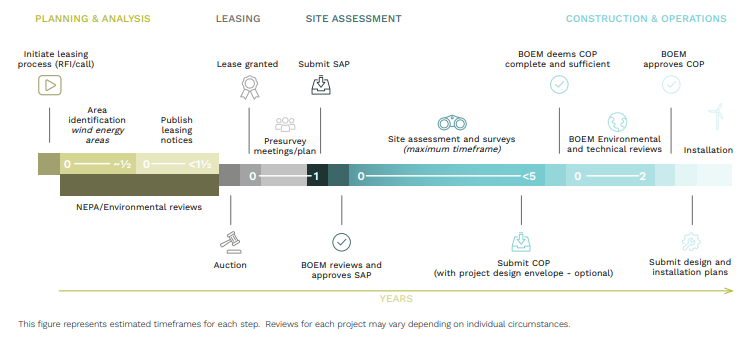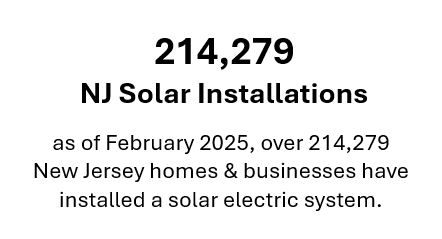Bureau of Ocean Energy Management (BOEM)
Bureau of Ocean Energy Management
In the United States, areas for potential development of offshore wind energy are determined by the federal government through the Department of the Interior, specifically the Bureau of Ocean Energy Management (BOEM). Seventeen lease areas have been designated by BOEM, with six lease areas located offshore of New Jersey. BOEM is also the lead agency on the federal policy and permit processes for offshore wind energy projects as outlined below.
The offshore wind development process commences when BOEM releases Call Areas which are locations identified for public comment during the Call for Information and Nomination stage to explore interest in commercial wind energy leases in the area. After reviewing the comments received from the Call for Information and Nomination process, BOEM releases wind energy areas (WEAs), which are locations in federal waters determined by BOEM to be most suitable for development. BOEM conducts further reviews to identify smaller section within each WEA as lease areas to be specifically developed for offshore wind arrays. Lease areas are auctioned by BOEM to offshore wind developers for opportunity to plan, construct, and operate offshore wind projects. Once a developer acquires the opportunity to possibly develop a lease area, states, such as New Jersey, and other stakeholders work with developers and federal agencies to plan and approve the development of specific wind projects.
After BOEM announces official WEAs, environmental assessment under the National Environmental Policy Act (NEPA) begins. This process considers leasing site characterization, and site assessment activities in the WEAs. Following BOEM’s Proposed Sale Notice, leasing process, and Final Notice of Sale, offshore wind developers obtain leasing rights and prepare a site assessment plan (SAP) and construction and operation plan (COP). These plans are submitted to BOEM for review and approval, with the COP being subject to public review and comment under NEPA.
Offshore Wind State Permitting
New Jersey is a key stakeholder in the offshore wind project review process. The New Jersey Department of Environmental Protection (NJDEP), has authority for State permitting and regulatory oversight of offshore wind energy transmission cables and infrastructure built in state waters, as well as onshore activities. This includes activities such as construction of electrical substations and installation of transmission lines. Relevant NJDEP permits include the Coastal Area Facilities Review Act Permit, the Waterfront Development permit, Freshwater Wetlands permit, Coastal Wetlands permit, Flood Hazard Area Control Act permit, Water Quality Certificate under section 401 of the Clean Water Act, and a Tidelands Conveyance.
NJDEP will also review offshore wind projects for consistency pursuant to the Coastal Zone Management Act (CZMA). The CZMA establishes a formal review process commonly known as federal consistency review. Federal consistency provides an opportunity for states to review federal agency activities which as reasonably foreseeable effects on any land or water use, or natural resource of the coastal zone, to ensure consistency with the enforceable policies of a State’s federally approved Coastal Management Program. NJDEP will review offshore wind projects for a federal consistency during a project’s environmental review period.
New Jersey solicits the purchase of offshore wind energy in the form of electricity generated by a proposed project over a specified timeframe. New Jersey’s mechanism for funding offshore wind projects is based on the offshore wind renewable energy certificate (OREC), N.J.A.C. 14:8-6.6 and 6.7. The Offshore Wind Economic Development Act (OWEDA), N.J.S.A. 48:3-87 et seq., requires the NJBPU to designate offshore wind projects eligible to receive ORECs, which are then called Qualified Projects. The OREC is fixed for each year over the first 20 years of each phase of the project’s commercial operation. For each megawatt-hour generated and delivered to the transmission grid, an approved project will be credited with on OREC. In return for the sale of ORECs, Qualified Projects are required to return all revenues received, including, but not limited to, sales of energy, capacity, and, if applicable, ancillary services, into PJM’s wholesale markets.
Figure Title: Federal Offshore Wind Process








.jpg)
.jpg)
